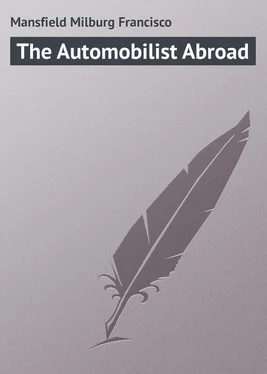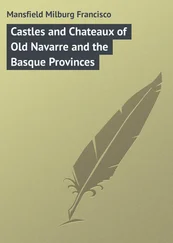Milburg Mansfield - The Automobilist Abroad
Здесь есть возможность читать онлайн «Milburg Mansfield - The Automobilist Abroad» — ознакомительный отрывок электронной книги совершенно бесплатно, а после прочтения отрывка купить полную версию. В некоторых случаях можно слушать аудио, скачать через торрент в формате fb2 и присутствует краткое содержание. Жанр: Путешествия и география, foreign_prose, foreign_language, на английском языке. Описание произведения, (предисловие) а так же отзывы посетителей доступны на портале библиотеки ЛибКат.
- Название:The Automobilist Abroad
- Автор:
- Жанр:
- Год:неизвестен
- ISBN:нет данных
- Рейтинг книги:4 / 5. Голосов: 1
-
Избранное:Добавить в избранное
- Отзывы:
-
Ваша оценка:
- 80
- 1
- 2
- 3
- 4
- 5
The Automobilist Abroad: краткое содержание, описание и аннотация
Предлагаем к чтению аннотацию, описание, краткое содержание или предисловие (зависит от того, что написал сам автор книги «The Automobilist Abroad»). Если вы не нашли необходимую информацию о книге — напишите в комментариях, мы постараемся отыскать её.
The Automobilist Abroad — читать онлайн ознакомительный отрывок
Ниже представлен текст книги, разбитый по страницам. Система сохранения места последней прочитанной страницы, позволяет с удобством читать онлайн бесплатно книгу «The Automobilist Abroad», без необходимости каждый раз заново искать на чём Вы остановились. Поставьте закладку, и сможете в любой момент перейти на страницу, на которой закончили чтение.
Интервал:
Закладка:
1. Sharp corners and excessive road cambers lead to slip, and, therefore, to dust.
2. More dust is raised on a rough road than on an equally dusty smooth road.
3. Watering the road moderately diminishes the dust.
4. The spreading on the road of crude oil, or of oil emulsions in water, is an important palliative.
5. Wood, asphalt, cobblestones, and square pavings are not dusty save after use by horse traffic.
6. Cars with smooth, boat-shaped under surfaces are less dusty than others.
7. Cars with large mud-guards and leather flaps near the road are more dusty.
8. Cars on high wheels well away from the ground are less dusty.
9. Cars with large tool-boxes at the back reaching low down between the back wheels are dusty.
10. Large car bodies are often dustier than small ones.
11. Blowing the exhaust near the ground increases the dust.
12. Cars fitted with engines having an insufficient fly-wheel or a non-uniform turning effort from any cause are more dusty.
13. A car mounted on very easy springs having a large up-and-down play will suck up the dust with each rise and fall of the body on rough roads.
14. Front wheels – or rolling wheels – raise less dust than back wheels or driving wheels.
15. Smooth pneumatic tires are dusty.
16. Solid or pneumatic rubber tires are more dusty at higher speeds, and with high-powered engines.
17. Non-skid devices, such as small steel studs, etc., do not increase the dust.
A writer on automobilism and roads cannot leave the latter subject without a reference to some of the obstructions and inconveniences to which the automobilist has to submit. If the automobilist proved himself a "road obstruction" like any of the following he would soon be banished and the industry would suffer.
A correspondent in the Auto , the chief Parisian daily devoted to automobilism, gave the following list of obstructions encountered in a journey of a thousand kilometres:
1. Drivers having left their horses entirely unattended – 75
2. Drivers who would not make way to allow one to pass – 86
3. Drivers asleep – 8
4. Drivers not holding the reins – 12
5. Drivers in carriages, or carts, without lights at night – 81
6. Drivers stopping their horses in the middle of the road or at dangerous turnings – 2
7. Drivers allowing their horses to descend hills unattended while they walked behind – 18
8. Dogs throwing themselves in front of one – 35
9. Flocks of sheep met without guardians near by – 8
10. Cattle straying unattended – 10
11. Geese, hens and children in the middle of the road – 30
Instead of seven sins, any of which might be deadly, there are eleven. Legislation must sooner or later protect the automobilist better than it does to-day.
Chapter IV
Hotels & Things
In all the literature of travel, that which is devoted to hotels has been conspicuously neglected. Certainly a most interesting work could be compiled.
Among the primitive peoples travellers were dependent upon the hospitality of those among whom they came. After this arose a species of hostelry, which catered for man and beast in a more or less crude and uncomfortable manner; but which, nevertheless, was a great deal better than depending upon the generosity and hospitality of strangers, and vastly more comfortable than sleeping and eating in the open.
In the middle ages there appeared in France the cabaret , the gargot , the taverne , and then the auberge , many of which, endowed with no more majestic name, exist even to-day.
is a sign frequently seen along the roadways of France, and even in the villages and small towns. It costs usually ten sous a night for man, and five sous for his beast, though frequently there is a fluctuating price.
The aubergiste of other days, on the routes most frequented, was an enterprising individual, if reports are to be believed. Frequently he would stand at his door and cry out his prices to passers-by. " Au Cheval Blanc! On dine pour douze sous. Huit sous le cocher. Six liards l'écurie. "
With the era of the diligences there came the Hôtels de la Poste, with vast paved courtyards, great stables, and meals at all hours, but the chambers still remained more or less primitive, and in truth have until a very recent date.
There is absolutely no question but that automobilism has brought about a great change in the hotel system of France. It may have had some slight effect elsewhere, but in France its influence has been enormous. The guide-books of a former generation did nothing but put an asterisk against the names of those hotels which struck the fancy of the compiler, and it was left to the great manufacturers of " pneumatiques " for automobiles to carry the scheme to a considerably more successful issue. Michelin, in preparing his excellent route-book, bombarded the hotel-keeper throughout the length and breadth of France with a series of questions, which he need not answer if he did not choose, but which, if he neglected, was most likely taken advantage of by his competitor.
Given a small chef-lieu , a market-town in France, with two competing establishments, the one which was marked by the compiler of this excellent road-book as having the latest sanitary arrangements, with perhaps a dark room for photographers, stood a much better chance of the patronage of the automobile traveller than he who had merely a blank against the name of his house. The following selection of this appalling array of questions, used in the preparation of the Guide-Michelin, will explain this to the full:
Is your hotel open all the year?
What is the price per day which the automobilist en tour may count on spending with you? (This is purposely noncommittal so far as an ironbound statement is concerned, being more particularly for classification, and is anyway a much better system of classification than by a detailed price-list of déjeuner, dîner , etc.)
What is the price of an average room, with service and lights? (Be it noted that only in avowed tourist resorts, or in the case of very new travellers, are the ridiculous items of " service et bougie " – service and lights – ever charged in France.)
Is wine included in your regular charges? (And it generally is except in the two above-mentioned instances.)
Have you a sign denoting adherence or alliance to the A. G. A.?
Have you a sign denoting adherence or alliance to the A. C. F.?
Have you a sign denoting adherence or alliance to the T. C F.?
Have you an arrangement with the Touring Club de France allowing members a discount of ten per cent.? (Some four thousand country hotels of France have.)
Have you a bath-room?
Have you modernized hygienic bedrooms?
Have you water-closets with modern plumbing? (Most important this.)
Have you a dark room for photographers?
Have you a covered garage for automobiles? (This must be free of charge to travellers, for two days at least, or a mention of the hotel does not appear.)
How many automobiles can you care for?
Have you a telephone and what is its number?
What is your telegraphic address?
What are the chief curiosities and sights in your town?
What interesting excursions in the neighbourhood?
This information is afterwards compiled and most clearly set forth, with additional information as to population, railway facilities, etc.
The annual of the Automobile Club de France marks with a little silhouetted knife and fork those establishments which deserve mention for their cuisine , and even marks good beds in a similar fashion. Clearly the makers of old-time guide-books must wake up, or everybody will take to automobiling, if only to have the right to demand one of these excellent guides. To be sure the same information might to a very considerable extent be included in the recognized guide-books; indeed Joanne's excellent series has in one or two instances added something of the sort in recent editions of their "Normandie" and "Provence," but each volume deals only with some special locality, whereas the Guide-Michelin deals with the whole of France, and the house also issues another covering Belgium, Holland, and the Rhine country.
Читать дальшеИнтервал:
Закладка:
Похожие книги на «The Automobilist Abroad»
Представляем Вашему вниманию похожие книги на «The Automobilist Abroad» списком для выбора. Мы отобрали схожую по названию и смыслу литературу в надежде предоставить читателям больше вариантов отыскать новые, интересные, ещё непрочитанные произведения.
Обсуждение, отзывы о книге «The Automobilist Abroad» и просто собственные мнения читателей. Оставьте ваши комментарии, напишите, что Вы думаете о произведении, его смысле или главных героях. Укажите что конкретно понравилось, а что нет, и почему Вы так считаете.












